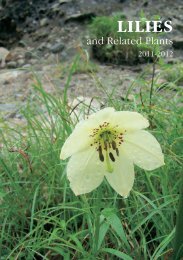LILIES - RHS Lily Group
LILIES - RHS Lily Group
LILIES - RHS Lily Group
Create successful ePaper yourself
Turn your PDF publications into a flip-book with our unique Google optimized e-Paper software.
iver whose broad meanders we had crossed and re crossed getting here and<br />
whose significant impact on the landscape seemed hard to reconcile with the<br />
insignificant stream that emanated from a modest hole in the ground in the<br />
corner of this municipal park. After a hearty breakfast at a local Diner, we took<br />
the road that leads to Mt Shasta. It wasn’t too long before one of us spotted<br />
some lilies by the roadside. After parking our vehicle under a tree, some shade<br />
being necessary as the temperature was about 40°C, we walked back to where<br />
some L. washingtonianum var. purpurascens were growing through Manzanita<br />
plants, their tough protectors against grazing deer. The furnace-like heat and<br />
resulting hard and parched soil certainly exemplified dry-land lily conditions.<br />
The miracle was that something so fine and, apparently, so delicate could take<br />
such punishment. I theorised, to myself, that, below ground, there might still be<br />
some residual snow-melt moisture that enabled the bulb to counteract the grilling<br />
effect of the sun on the stem and flowers, but I would have needed a pickaxe to<br />
reveal the bulb and test my theory and, apart from any ethical considerations, all<br />
I had with me was a plastic spoon!<br />
When we arrived at Orleans, having driven north, again, from Mt Shasta, we<br />
checked-in to the Orleans Mining Co., a Motel that proved to be as intriguing<br />
as its name. Among its other attractions, it had what, with a stretch of the<br />
imagination, could be called a museum of mining tools and other dusty artefacts,<br />
but I was disappointed to find that there wasn’t even a trace of Orleans’ most<br />
famous denizen – Bigfoot! Bigfoot or the Sasquatch, as well informed readers<br />
will know, is America’s version of the Abominable Snowman or Yeti and he,<br />
she, it ??? was first observed near Orleans in 1958. Sadly, despite driving many<br />
miles through the backwoods above Orleans in search of lilies, I, again, found<br />
no trace of Bigfoot. However, the temperature was between 30 and 40°C, far too<br />
uncomfortable for someone to be wandering about in a gorilla suit I suppose.<br />
Not bumping into Bigfoot was disappointing, but the many lilies we saw, as we<br />
looped north from Orleans into the wooded hills of Humboldt County and then south<br />
to pick up the road that took us west to Eureka and the Pacific coast, were a glorious<br />
compensation. The first and last species we encountered was L. rubescens, but while<br />
the first plants were, characteristically, upward facing with tepals that fell gracefully<br />
downwards, the last plants had tepals that were more rigid which gave the flowers<br />
a star shaped appearance. The second species we found was L. kelloggii, a happy<br />
accident that came about because we missed the turn off to Onion Lake. Another<br />
unexpected bonus was to find a yellow form of L. kelloggii, albeit with a single<br />
insect-damaged flower, which our resident expert Barb had never seen before and<br />
which none of the standard lily reference books mention. Back on track we were<br />
soon at Onion Lake, which was far more beautiful than its prosaic name suggests,<br />
and investigating some plants of L. pardalinum, L. wigginsii and their hybrid<br />
74




